 September 2001
vol. 56 no. 3
Back to Table of Contents
September 2001
vol. 56 no. 3
Back to Table of Contents
Note: The photos included with this article come from the thousands of General Conference India missions photos in the holdings of the Mennonite Library and Archives. Although the article does not deal directly with the region of the General Conference mission, the social conditions there were much the same as in other Mennonite mission areas in India. The captions are taken from the backs of the photos; some of them appear to be in P. A. Penner's handwriting.
India is a diverse, multi-religious, multi-cultural country with a population of over one billion people. It is commonly believed that India is a Hindu country and that Hindus constitute over 80 percent of the population. But the emergence of the Dalit movement and intellectual awakening of Dalits has revealed a different reality. We now know Backward Castes, Scheduled Castes, Scheduled Tribes, and other religious minorities like Christians, Muslims, Buddhists, and Parsees constitute 85-90 percent of the total population. Only 10-15 percent are so-called Hindus. (1)
India is unique both in general history and religious history. The ancient Indus Valley civilization dates back to 3250 B.C. Indian religions such as Hinduism, Buddhism, Jainism, and Sikhism not only influenced the philosophy and thought of Asia but also of the world. Out of 6000 spoken languages in the world, 1645 languages are spoken in India itself.
The history of any church or any new movement cannot be explained or understood without studying the context or background in which the movement emerged or the event occurred. Therefore the aim of this essay is an attempt to discuss the socio-economic, political, and religious conditions in India in general and in North Bihar and Chotanagpur in particular at the advent of Christian Missions and how they paved way for the conversions to different religions and to Christianity.
Political History in Brief
The general history of India can be divided into five distinct periods. First, Ancient India (Indus valley civilization, 3250- 2000); Second, the Hindu period (2000 B.C. to 1001A.D), in which the rulers were Hindus and both Hinduism and Buddhism developed. Third, the Muslim Period (1002-1757) when Islam entered India and was firmly established. Fourth, the period of East India Company and British Colonialism (1757-1947). During this period the East India Company gained a stronghold on the country and established trade. The British were able to take supremacy in this period that lasted until 1947. The final period is independent India (1947- ). In 1947 India and Pakistan were divided as independent countries. Following independence, the 562 independent native states of India were absorbed into the central government. With the formation of three more new states (Chathishghar, Jharkhand, and Uttaranchal) in November 2000, the number of Indian states grew to twenty nine. The division of the states was made mainly along language lines.
A small percent of Aryan minority (3-4 % of Brahmins) ruled this country--the largest democratic society in the world--by manipulating the rulers, parties and religions since its independence. (2)
Advent of Christianity in India
Strong Indian tradition holds that one of our Lord's disciples, Thomas, brought Christianity to India in 52 A.D. Whether the apostle Thomas actually brought Christianity to India is still a matter of argument. Nevertheless, it seems that a church has existed in South India since the early part of the Christian era. Traditionally this is called St. Thomas Church or Syrian Church.
Roman Catholicism reached India through the Portuguese explorers during the fifteen and sixteenth centuries. Their pioneering missionary was Francis Xavier and the next significant missionary was Robert De Nobili. Later several Roman Catholic missionaries stopped briefly in India on their way to China. By the end of the 18th century, the Roman Catholic Church declined in India and was not revived until about the middle of the nineteenth century.
In 1793 a new era in modern mission began in India with the arrival of William Carey of the British Baptist Mission. Other Protestant mission societies followed. The socio-cultural and religious conditions in India at the time of the arrival of modern missionaries help explain the success of their mission work. There were the centuries-old deep-rooted customs and beliefs, which were often part of the religious systems. These included child marriage, polygamy, female infanticide, suttee, the belief that education is not necessary for girls, superstitions, the caste system, and untouchability.
Untouchabilty is perhaps the most important feature that needs to be understood for the conversion of Dalits who constitute approximately 70% of the Indian Christian population. About 99% of present Mennonite Brethren come from the formerly "untouchable" Dalits. The Dalits in fact were called the "untouchables."
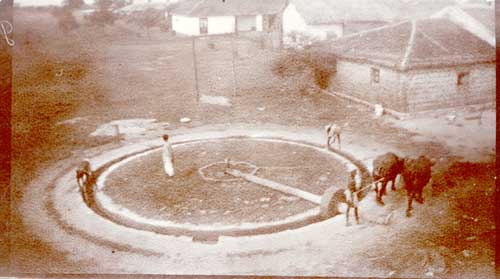
Dalit Conversions
The Meaning of the term Dalit and the plight of Dalits
The term 'Dalit' has come into popular use in India in recent times. The word comes from the Sanskrit root word "dal" that means to crack, split, broken, down trodden, crushed, destroyed, oppressed, poor, and helpless. This word can be used for all three genders: masculine, feminine, and neuter. Today the term 'Dalit' is used for people who on the basis of caste distinction have been considered 'out-caste' and were not included in the Hindu four-fold caste structure. These people were called names such as Chandalas, Panchamas, Avarnas, Dasya, Out-caste, etc,. The British referred them as the "depressed classes." Gandhi coined the word "Harijan" and the Government named them "Scheduled Castes." But today these people preferred to use the term "Dalit" for themselves because this term became an expression of hope for them in their struggle to recover their past identity. Through their struggle against oppression, this term Dalit gained a new connotation, which has more positive meaning. (3)
Dalit does not mean low caste or poor. It rather refers to the state of a section of people who have been reduced and now are living in that predicament. Thus the word Dalit describes a condition but not a connotation of inferiority. James Massey, a prominent Dalit theologian, explains the wide usage of the term Dalit as follows:
|
Dalit is thus not a mere descriptive name or title, but an expression of hope for the recovery of their past identity. The struggle of these 'outcastes' has given the term Dalit a positive meaning. The very realisation of themselves as Dalit, the very acceptance of the state of 'dalitness,' is the first step on the way towards their transformation into full and liberated human beings. (4) |
Although they were the original inhabitants of the land, Dalits were oppressed, exploited, and marginalized for centuries before the beginning of modern period. Though the Dalits have interesting traditions and legendary stories to trace back their origin to high status, caste, and position in the past, they were gradually reduced to the position of "no people" in the name of the caste system and with the principal of "purity and pollution." They were considered untouchables because of the work that was assigned to them by the law of Manu and were pushed to the peripheries of the village. Dalits were subjected to do all menial work in the villages which no others were willing to do. This work included sweeping the streets of the villages, serving the caste people as bonded slaves, removing dead animals from the villages, making leather works, digging graves, etc. Because of such occupations they were considered as untouchables, unspeakables, unseeables, unapprochables, unmentionables, and even unthinkables.
They were expected to maintain 66 feet distance from the Brahmins and 33 feet from the other castes. They were denied access to public places and wells. They were not allowed to enter the colony of the caste people. When they walked in the public streets they were to tie a palm leaf around their waist so as to wipe their footprints and were to tie an earthen vessel around their neck to spit their spittle, so that they would not pollute the village. Dalit women were forbidden to wear any cloth above their waist and below knees. This however has changed over the years.
Religiously Dalits were strictly barred from entry into any Hindu temples. Brahmins did not serve them as their priests. The temple entry movement was a revolt against this. The Dalits in the village have had entry into the temples only for the past thirty to forty years, and they are still not part of the temple administration, nor they are allowed to actively participate in the cults. (5)
Economically also Dalits were poor because practically they were bonded slaves attached to one master whom they served through generations. For all their services they received their wages in kind at the time of harvest. Therefore during the droughts and famines they were the first victims. John E. Clough, Baptist missionary at Ongole of Andhra Pradesh wrote, "going hungry many a day in the year produced a willingness to eat what no one else would have touched. The consequence was that the men and women had poisoned blood in their veins. The children were full of sores." (6)
G. W. H. Brook, another Baptist missionary who worked many years among Dalits described the plight of the Dalits during the drought saying that they "compete with the dogs, jackals and foul birds of the air for the carcasses of the cattle that die in the villages." (7) Therefore A. P. Nirmal, pioneer Dalit theologian, wrote that Dalits were not just "No people" but "No humans." (8)
There was a series of protests and resistance movements among the Dalits from the 14th century onward. (9) The intensity of the protests and the forms they took varied according to the social context, time, and place from which they emerged. Dalits in the past expressed their feelings of pathos and protest in various forms. The Bhakti Movement in the 14th and 16th centuries, Sanskritization, self-assertion movements, and mass movements in 19th and 20th centuries were part of such protest.
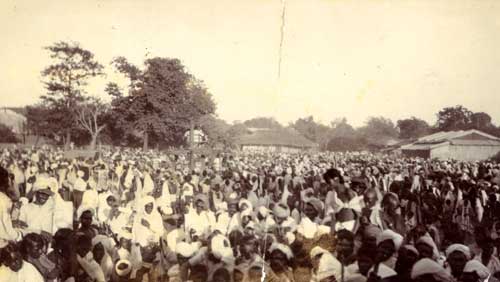
Why Dalits Converted to other Faiths
Because Dalits and other backward castes were victims of Hinduism and the caste system, they converted to other religions for self respect, human dignity, and religious identity. For Dalits, conversion appeared as the only solution. Dr. B. R. Ambedker, who was a champion of Dalit uplift, said they could not get equality by remaining as Hindu in Hinduism, so he recommended conversion to the other egalitarian religions as the only solution. He said:
|
To reform the Hindu society is neither our aim nor our field of action. Our aim is to gain freedom. We have nothing to do with anything else. If we can gain our freedom by conversion, why should we shoulder the responsibility of reforming the Hindu religion? And why should we sacrifice our strength . . . the object of our movement is to achieve social freedom for the untouchables. It is equally true that freedom cannot be secured without conversion. (10) |
He further said, "conversion brings happiness I tell you all very specifically, religion is for man and not Man for religion. To get human treatment, convert yourselves. Convert for getting organized, Convert so that your domestic life may be happy." (11) He also declared "I will not die as a Hindu." Even in death he did not want to die in the suffocating society of caste.
Therefore Dalits marched towards conversion into other religious faiths. Ambedker himself choose Buddhism. Thus we have Dalits in all religions. In Punjab a substantial number of Dalits chose Sikhism. In Maharashtra they converted to Buddhism. In Kerala, Tamil Nadu, and Andhra Pradesh they turned to Christianity and Islam. Thus 70-90% of people in different faiths are from Dalit origin. The Dalit movement in the 20th century liberated and provided religious identity and individual dignity to the millions of Dalits in India who were marginalized for centuries by the caste system.
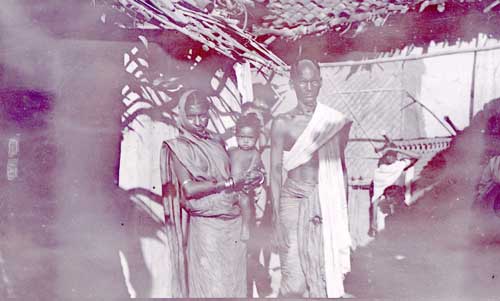
Dalits and Christian Missionaries
With the coming of the Protestant missionaries with their emphasis on the equality of all human beings and educational opportunity, a door opened for Dalits social mobility.
Protestant missionaries in the modern period came with the background of the evangelical revival and industrial revolution. These events in their countries shaped their ideology and theology. These motivated the missionaries to take an active part in the struggles of the poor, exploited, and marginalized Dalits. Therefore when such missionaries came to India, they "were predisposed to interest themselves in the Dalits. Thus while all missionaries came with the zeal to convert the 'heathen,' they also involved themselves with the attempts to improve the conditions of the down-trodden and the underdogs--mainly, the Dalits." (12)
However, according to Stephen Fuchs (13) and M. E. Prabhakar (14) the Messianic Movements (15) also prepared a ground for acceptance of Christianity. Two examples were Yogi Potuluri Veerabrahmam and Yogi Nasraiah in Andhra Pradesh. Veerabrahmam belonged to a carpenter's family in the Telugu region. He lived in the first half of the nineteenth century. He was a devotee of Shiva and was said to have performed many miracles before he entered his grave alive. He preached mainly against the caste system and promoted millennial expectation of a coming time when the caste system would be destroyed and the equality of all men and women established. Thus Veerabrahmam is said to have inspired thousands of Dalits in Andhra Pradesh, somewhat in line with the millennial hope of Christianity. As a result thousands of his followers embraced the Christian faith, finding a fulfillment in Christ when missionaries arrived and preached.
According to the available records Yogi Nasraiah was a Muslim. His original name was Nasar Mahommed. He too lived in the first half of the nineteenth century in present Narasaravapeta area of Andhra Pradesh. People called him 'Guru Nasaraiah' instead of Nasar Mohammed. He preached the doctrine of one God, love, and forgiveness. He had also preached that idols were useless and advocated equality of the sexes. One of his earliest converts was a Dalit, therefore many Madigas (Dalits) became his followers. Emma Raushenbush Clough (16) wrote that when the movement towards Christianity began among the Madigas ( Dalits), the men and women who were following Nasariah sect were among the first to open their hearts to the divine life in Christ. The followers of Nasaraiah later became the Disciples of Christ.
John Everrt Clough of American Baptist Mission, when he came to Ongole of Andhra Pradesh in March 1866, was easily convinced that he should work among the Dalits ( Madigas), even though he had come with a mind to concentrate on the high caste people. After seeing the misery of the Dalits (Madigas) he wrote:
|
I saw that it had come to this: If I continued to receive the Madiga I would have to identify myself with them. Their sorrows would be laid upon me. The hardships of their position would be mine to bear. Despised on their account, rejected by the other castes, I would have to begin at the bottom round of the ladder in India, and see about climbing up, carrying the Madigas with me. (17) |
Having come to know the conviction of Clough, A. V. Thimpany, a fellow missionary at Nellore, wrote a him a letter:
|
Go on baptizing brother those 'elect of God'. A converted Madiga is as good as, and, if more pious, better, in the eye of God and than a converted Brahman. God knows the best how to work. He is working from the bottom upward. (18) |
Eventually, the mission in Ongole became a 'Madiga Mission' and Clough became a 'Madiga Dora'. Mission work at Mahabubnagar district, which later became one of the Mennonite Brethren mission fields, was an extension station of this mission. In many ways Chute, a pioneer Baptist missionary to the district, shared the ideology and policies of Clough.
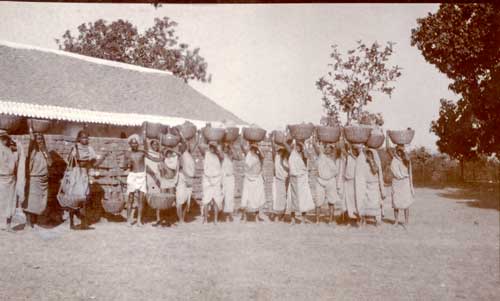
Dalits and Mennonite Brethren
The Mennonite Brethren Mission which concentrated in Mahabubnager District of Andhra Pradesh had a double reason to concentrate on Dalits. They not only had came with a modern Protestant missionary background but they also shared the Anabaptist-Mennonite tradition. The Anabaptist -Mennonite movement had been a movement of the poor, the peasants, and the exploited. (19) Furthermore they were attracted to India by the success of Clough's mission among the Madigas ( Dalits) at Ongole. (20) Consequently Daniel Bergthold, one of the four pioneer missionaries for M. B. mission, as soon as he reached Nagarkurnool of Mahabubnagar District concentrated on Dalits:
|
While looking for a second AMBM field, the Bergtholds were soon introduced to the Madigas, the leather worker caste. Daniel Bergthold wrote that 'though they live in the dirt of India, we have our greatest success with them'. Observing them in their suppressed condition and comparing the caste system with an earlier civilization as he conceived of it, he became quite convinced that Darwin's theory did not apply here. His view was that the Caste system had 'reversed progress' from that earlier civilization. (21) |
The American Mennonite Brethren Mission, after occupying the mission field in the district, adopted the strategies of the American Baptists. J. B. Toews commented that during the first half of the 20th century "our theology of mission, strategy, and methods and church planting were largely an adoption from the Baptists." (22)
Factors that led to Dalit Conversions to Christianity
As the Dalits were the poorest of the poor, some people tend to see their conversion movement as a way to get material benefits. However, historians in India today agree that the motives were deeper than the grasp for material benefits. The motives might have been social, religious, and then economic. The general consensus among historians in India is that the underlying motivation was the search for improved social status, for a greater sense of personal dignity and self-respect, or freedom from bondage from oppressive land owners. (23) Dr. George Oommen, reflecting about the Pulayas struggle in South India, wrote of "their determination to maintain a sense of human dignity and receive better treatment from the higher castes". (24)
Thus it appears clear that along with religious identity, the main motives for conversion were human dignity, self respect, and the desire to be treated as equal human beings. When Clough hesitated to baptize the Madigas they shouted "we do not want help. By the blisters on our hands we can prove to you that we have worked and will continue to work. If the next crop fails, we shall die. We want to die as a Christians. Baptize us!" (25)
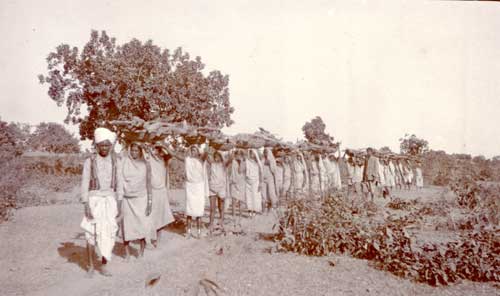
Tribal Conversions
While Dalits of South and Central India were converting to Christianity, in Northeast India, Chotanagpur and North Bihar witnessed a substantial conversion movement of the tribal peoples of that region to Christianity.
Geographical and political setting
Chotanagpur and North Bihar states also were not an exception in this conversion movement. Normally the North is called "graveyard for the mission and mission movement," but the conversion movement of tribal peoples in Chotanagpur negates such argument. The people of this region positively responded to the gospel with the coming of Christian missions in the late 19th and early 20th centuries.
Chotanagpur is surrounded by land on all sides--the great Himalayas in the North Madhya Pradesh and Utter Pradesh in the west, Orissa in the south and Bengal in the east. North Bihar is extremely fertile because it is constantly watered by the rivers Sarayu, Ganges, and Gandak. The large two plateaus, Ranchi and Hazaribagh, are situated almost at the center of Chotanagpur plateau.
Bihar had a glorious ancient history. It was the home state of the Mauryan Empire. Under the great king Ashoka, Pataliputra became famous. Its fame continued under the Magada and Gupta dynasties. But under the Sultans of Delhi and later under the Mogal Emperors Bihar was reduced to the status of a province.
With the decline of the Mogal empire Bihar was under the Nawabs of Bengal. In 1764 the British took the region from the Nawab of Bengal in the famous battle of Busear in Bihar. Since then Bihar was a part of Bengal Presidency. In 1911 Bihar and Orissa were separated from the Presidency of Bengal and in 1936 both became separate provinces. This is the brief history of Bihar.
According to the 1991census nearly 90% of the people of Bihar live in rural areas. This makes Bihar one of the most rural states of India. Santal, Oraon, Munda, Ho, Kharia, Bhumij, and Birhor were the tribal groups of Bihar. Most of the tribal peoples live in the Chotanagpur plateau and Santal Pargana. The tribes of Bihar ethnologically belong to a pro-Austroid group but linguistically they do not have same language affinities. Austro Asiatic is divided into two language groups, Mohn Khemer and the Munda language groups. (26)
The tribal peoples of Chotanagpur were also called Adi-Vasis. They were the original inhabitants of the region. One of the tribes--Mundas--said once they snatched the land from the fangs of the snake and from the clans of the tiger. (27) After many centuries marauders came up from the plans to raid their positions. At the beginning, tribal peoples defended themselves with their hunting weapons, but later they could not defend themselves and lost most of their land.
Tribals and Christian Missions
At the arrival of missionaries, these tribal peoples were in an acute agrarian crisis. They were being gradually alienated from their land by moneylenders, the Zamindars, and were "thus being transformed into landless agricultural labourers." (28) Later on burdensome taxes were imposed upon them. In their poverty they sought loans "which they often could not repay because of the high interest charged." (29) Thus the lands were taken over and they were forced to become bonded laborers in some cases. "There was no limit to their exploitation. There was also no social intercourse between these adivasis and the Hindu or Muslim inhabitants of Chotanagpur," (30) wrote Sivaji Koyl.
It was in this context and among these economically exploited and socially oppressed tribal peoples that the missionaries arrived and preached the gospel of liberation.
Christian missionaries started to arrive in Chotanagpur from the middle of the 19th century. The first who arrived were the missionaries of the Gossner Evangelical Lutheran Mission. Four Lutheran missionaries arrived in Chotanagpur in November 1845. They were the first Protestant Christian missionaries in that part of India. These four young missionaries were E. Schutz, F. Batsch, A. Brandt and H. Jamke. They came and settled down at Ranchi. For a few years there was not a single convert. Then a strange incident occurred. One day four men of the Oran tribe came to the mission house asking to see Jesus, of whom the missionaries had been preaching. They were asked to attend the church service. Having done so, they were deeply impressed but still unsatisfied. "They wished and said to see Jesus with their own eyes." One of the missionaries took them into an inner room and prayed fervently that they might be guided to the light. They went away quietly.
Some time later the same men reappeared and asked again to be allowed to participate in worship service. At its close they came forward with great joy in their faces saying now they had found Jesus. Now they were satisfied and they desired to become Christians. (31) After further instruction and teaching they were baptized on June 9,1850. From then on the number of converts rapidly increased and by 1857 there were 700 baptized Christians. A church had been established in 1855. In the next ten years people movements among the Oraons and Mundas brought many converts and within ten years the baptized Christians numbered about 10,000. (32)
Thus the mission work continued, spread, and flourished. Apparently the tribal people came with their desire to become Christians. Sometimes a whole village came to missionaries asking for baptism.
An Anglican mission (The Society for the Propagation of the Gospel) arrived in this region in 1869. By 1872, the Anglican Church had consolidated their position and reported that they had 5,000 converts. (33) The Roman Catholic Church entered the region only in 1887 and established the mission work.
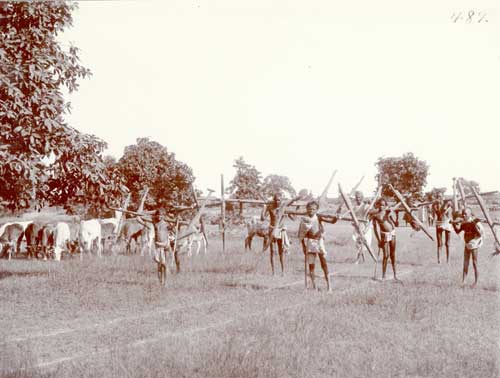
Factors that led to the Conversion of Tribal Peoples to Christianity in North India
C. F. Andrews, analyzing the factors for conversions in this region, wrote that one of the main factors leading to conversion was religious. Citing the incident of four men who came to find Jesus and returned saying "Now we have found Jesus, now we are satisfied and now we desire to become Christians," Andrews wrote that spiritual satisfaction was the primary motive for the conversion of tribal peoples in the Chotanagpur region. Further, however, he says that they might have come with the desire for the material help from the missionaries. But this was not without spiritual value:
|
However unworthy may have been the early motives of many in embracing Christianity, in embracing it they have found life: moral, intellectual and spiritual even now some of the Kol converts are being used for work as Catechists among the Gonds of the central provinces as well as in Calcutta and Assam (34) |
Andrews seems to be generalizing one isolated incident. It may not be true with all. Shivaji Koyal wrote that when the missionaries did not offer the people expected solutions to their problems, they broke away from the church. (35) Hence for him the factors would be more than spiritual.
At the arrival of missionaries in Chotanagpur the tribal peoples in that region were passing through an acute agrarian crisis. These missionaries who came from the background of the evangelical awakening began to give serious attention to economic and social problems. Therefore they sided with the peasants in those struggles against exploitation. Missionaries provided them with lawyers to plead their cases, gave advice, and helped them financially to fight for their cases. Missionaries for this purpose founded a mutual help society and co-operative credit societies for the mutual uplift of the converts. Establishment of schools, educational institutions, and the churches played a positive impact with regard to the intellectual awakening of the converts. Their primitive tribal superstitions with regard to spirits disappeared. According to C. F. Andrews the work of the mission not only raised the social and intellectual status of the converts but their whole life. Body, soul, and Spirit were raised after their conversion to Christianity. (36)
As the missionaries supported the cause of the oppressed tribal peoples in this area and helped them in their struggles against their economic exploitation, it was natural for the tribal peoples to convert to Christianity in large numbers. (37)
Substantial adherents of six Mennonite Brethren and Brethren in Christ groups in India come from either Dalit or Tribal background. The history and witness of these six groups need to be studied in their broader social context.
NOTES
1. Statistics which are based on historical facts are: Scheduled Castes ( SCs) 20%, Scheduled Tribes ( STs) 10%, Backward Castes ( BCs) 35 %, Muslims 15%, Christians 2.5%, Sikhs 2.5%.
2. Z. C. Devadanam, President of NCCI Dalit desk presented a paper on The Plight of Dalit Christians in Rural India, in NCCI consultation held in Madras in July 2000, 1.
3. See I. P. Asheervadam, "Dalit Conversions to the M. B. Church in Mahabubnager district of Adhara Pradesh in Pre-Independent India" (Unpublished M. Th. Thesis, 1998), 25 ff.
4. James Massy, Down Trodden: The Struggle of India's Dalits for Identity, Solidarity and Liberation (WCC, 1997), 3.
5. D. J. Prabhaker, "A Liberationist Re-interpretation of the Cross in the light of Dalit Experience of Suffering in Two Select Dalit Communities in A.P." (Unpublished Thesis Submitted to the Serampore University for the M. Th, U. T. C., Bangalore, 2000), 23.
6. John E. Clough, Social Christianity in Orient (1904), 64.
7. G. W. H. Brook, "Uplifting the non-Caste Madigas", Mission, vol. 2, April,1911, 238.
8. A. P. Nirmal, "Towards A Christian Dalit Theology," paper presented to UTC, Bangalore, 6.
9. See Taneti James Elisha, "Dalit Conversions to the Methodist Episcopal Church in North Karnataka in the first half of the Twentieth Century" (Unpublished Thesis Submitted to the Serampore University for the M. Th, U. T. C., Bangalore, 1998), Ch 2.
10. B. R. Ambedker, Why Go for Conversion (Dalit Sahitya Akademy, 1987), 5.
11. Ibid., 22.
12. F. J. Balasundaram, Dalits and Christian Mission in the Tamil Country (Bangalore, Asian Trading Corporation, 1997), 59.
13. Stephen Fuchs, Rebellious Prophets: A Study of Messianic Movements in Indian Religions (Bombay, Asia Publishing House , 1965), 250ff. Hereafter, Fuchs, Rebellious Prophets (1965).
14. M. E. Prabhakar "Caste-Class and status in Andhra Churches implications for mission today," Religion and Society, Vol XXVIII, No.3. September 1981, 25. Hereafter Prabhakar, "Caste-Class," 1981.
15. Messianic movements taught faith in a savior or Messiah who is expected to arise at the end time. See Stephan Fuchs, Rebellious Prophets.
16. It is said that Mrs. Emma Raushenbush Clough was a sister of Walter Rauschenbush who advocated the Social Gospel in America. Her book, Social Christianity in the Orient, shows that they came with that influence.
17. Clough, Social Christianity (1904), 128.
18. Ibid., 132.
19. See I. P. Asheervadam, "Anabaptist Movement as a People's Movement: A Perspective," a paper presented in Integrated Seminar at UTC, Bangalore.
20. Peter Penner, Russians, North Americans, and Telugus (Winnipeg: Kindred Productions, 1997), 4. Hereafter Peter Penner, The M. B. Mission in India.
21. Ibid., 39, Quoted from Bergthold letter Jan 31st 1906.
22. Ibid., 141.
23. See John C. B. Webster, The Dalit Christians: A History, p. 57. G. A. Oddie (ed), Religion in South Asia . George Oomen, The Struggle of Pulaya Christian for Social Improvement. These historians have drawn conclusions from the particular examples taken from case, region, or caste groups and argued that the main motive for conversions to Christianity was the aspiration of Dalits to escape from the discrimination and oppression of the high caste groups. Thus they argue that one of the primary motives was social aspiration. It was their motive to improve their social status, in particular to remove the stigma of untouchabality.
24. George Oommen, Pulaya Christians, 1.
25. J. W. Pickett, Christian Mass Movements in India (1933), and D. B. Forrest, Caste and Christianity (1980), 77.
26. Albart Vasanthraj (ed), Bihar, Church and People Groups (1992), 14.
27. Ibid., 52.
28. Sivaji Koyl, "A critique of the Missionary Movement in Chotanagpur," ICHR, Vol.19, 1988,140.
29. Ibid., 140.
30. Ibid.
31. C. F. Andrews, Hand Book of English Church Expansion: North India (1908), 37-38.
32. Albert Vasanthraj, 26.
33. Pickett, 46.
34. Andrews, 43.
35. Shivaji Koyal, 149.
36. Andrews, 51.
37. Shivaji Koyal, 147.